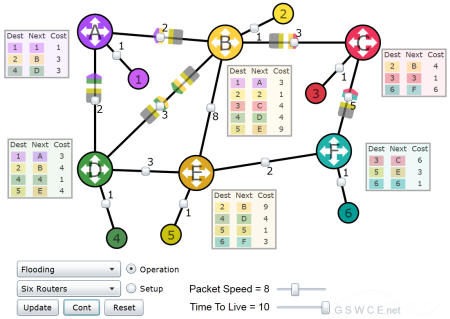This page currently hosts the demos about communications protocols. There are a few more of these in the works (MAC protocols, spanning trees, Bellman-Ford and the token bucket algorithm). Any other ideas, please let me know.
Click on the title or the picture to get the full demo.
Currently on this page are the following:
 |
Flow Control DemoNot completely bug-free this one yet, but since I’ve started using this myself I thought I should put it up here. Hopefully what it does is reasonably self-explanatory, however note that the “Satellite” checkbox slows down the second link to simulate what happens on a satellite link. Proxies have infinite buffer space, routers have buffer space defined by the program. |
 If you spot this one doing anything odd, please let me know.Video instructions and demo on request… Back to top |
Error Detection Schemes DemoIllustrates the operation of parity, checksum, Internet-style checksums and the CRC. I like to use this one to demonstrate the effectiveness of the Internet checksum, and they challenge the students to work how much better they could do; then change to the CRC scheme, and just let them watch it carry on for minutes not suffering from any undetected errors at all. That gets their attention; and they get curious to wonder how CRCs work – and they need some motivation before they start on that bit of maths. |
 Video instructions and demo on request… Back to top |
IPv4 Address QuizDemo to provide some fun in lectures, and some practice outside. |
 Video instructions and demo on request… Back to top |
IPv4 Address Assignment DemoDemo to provide some practice in assignment blocks of IPv4 addresses, and to check answers that students have come up with to tutorial problems. Check one of the checkboxes next to the buttons to turn on a new subnet; then you can drag the block of addresses around. Each row of space is 256 addresses (a /24 block). |
 Video instructions and demo on request… Back to top |
Protocol Layers DemoMostly obvious, but there’s a bit more going on under the hood that might be immediately obvious. Firstly – right click on any packet and it will stop, left click and it will disappear. Reliable layers also re-order packets, and have a window size of seven packets. Also, when paused you can put the mouse over a header and get a description of what it is. |
 Video instructions and demo on request… Back to top |
Routeing DemoThis is a slightly more advanced version of one of the original VB demos about routeing. Originally just for demonstrating the operation of the Bellman-Ford algorithm, I’ve also added reverse path forwarding so I can use it for multicasting as well. Note the colours on the packets: in order from the front to the back they are MAC destination, MAC source, IP destination, IP source, data type (routeing packets are pink, broadcast packets are white). |
 Double-click on the routers to bring up the routeing tables, and left or right click on the costs of the links to change them. Packets are sent by clicking on the source, then dragging the gray line that appears to the destination.Video instructions and demo on request… Back to top |
Sliding Windows DemoAnother one with rather more going on under the hood than might be obvious at first sight. It can do some basic TCP congestion control stuff as well, implementing slow-start, delayed acknowledgements and fast re-transmit. Put the mouse over a pane in the window for more details; and you can kill packets by double-clicking on them, and pause and re-start them with a single click. |
 Video instructions and demo on request… Back to top |
Switching Comparison DemoDemonstrates the difference between message, circuit and packet switching, and shows the situations in which each of the them is the best choice. Quite basic this one, and needs a bit of description while it’s running. |
 Video instructions and demo on request… Back to top |
Token Bucket Algorithm DemoDemonstrates the token bucket algorithm. This is very much a work in progress, since it occurs to me that with not much modification this one could be used to demonstrate a lot of effects in queueing theory, and I’m due to start teaching that subject again next year. Watch this space for updates. |
 Video instructions and demo on request… Back to top |

Pingback: New Flow Control Demo just up | gswce.net